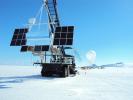Space Education
Out of this world research
December 8, 2023
Share

The International Space Station orbits over Earth. NASA. International Space Station (ISS) NASA ID: 0201587.
Why do astronauts experience a higher risk of anemia, and cavities? Can we prevent bone loss and cardiovascular diseases in people who stay in space for a prolonged period? How can we better preserve food in spacecrafts?
While exploring outer space has long been on humanity’s wish list, space travel still poses huge challenges. This is why space agencies and research institutions around the world have programs dedicated to science that investigate the impact of microgravity on human health and daily life. A group of undergraduate students at Queen’s is now joining this effort: In 2023, Queen’s joined the Student Spaceflight Experiments Program (SSEP), organized by the US-based National Center for Earth and Space Science Education (NCESSE) in the US and the Arthur C. Clarke Institute for Space Education, internationally. The program is enabled through a strategic partnership with Nanoracks LLC, which is working with NASA under a Space Act Agreement as part of the utilization of the International Space Station (ISS) as a national laboratory.
“This is a remarkable opportunity for our Queen’s community,” says Klodiana Kolomitro, Special Advisor, Undergraduate Research. “Our undergraduate students are showing once again the critical role they can have in research exploration and discovery.”
From September to November, 65 undergraduate students from health sciences, kinesiology, biology, computer sciences, physics, math, politics, history, and other disciplines participated in a team-based research course to develop experiments to be performed in a flight-certified mini-laboratory. The course was led by assistant professors Diane Tomalty and Olivia Giovannetti (Department of Biomedical and Molecular Sciences). During a recent showcase event, the students presented 14 experiment proposals addressing different research questions on how things work in a microgravity environment.
“Drs. Giovannetti and Tomalty navigated the mentorship of the students from many programs throughout the development of these interdisciplinary projects with exceptional aplomb,” says Michael Adams, Associate Dean (Undergraduate Studies), Queen’s Health Sciences. “To steal a quote from Dr. Arthur McDonald, 2015 Nobel-Prize laureate and a guest judge at the showcase event, ‘Wow, I was blown away’ with the seamless communication, collaboration, and advocacy I observed with each group. They clearly respected and valued each other to be able to develop such high-quality proposals.’”
Excitingly, one of the experiments designed by the Queen’s students will take part in a real space mission on the International Space Station, where it will be operated by astronauts. After four to six weeks in orbit, the experiment will return to the research team for analysis.
“Designing an experiment that can be run on the ISS and that addresses a real-world challenge is a difficult design problem that requires expertise from multiple disciplines,” says William Nelson, Associate Dean (Teaching and Learning), Faculty of Arts and Science. “Teams learned to excel at communicating among peers from different academic backgrounds and to synthesize diverse expertise to create real solutions. The final projects reflect the kind of innovation that is ignited by real-world teaching and learning opportunities that cross disciplines.”
Out of the 14 experiments proposed by Queen’s students, an internal committee selected three to be sent to SSEP, who then convened the SSEP Mission 18 National Step 2 Review Board, where one Queen’s-led experiment was selected to be sent to the ISS. SSEP selected the experiment "The impact of lectins on Escherichia coli biofilm formation in microgravity," and the estimated launch date of the ferry flight to the station is late-spring 2024.
Top experiment proposals
- Space anemia: investigating the impact of microgravity on erythropoietin for treatment implications
Students: Anthony Guglya, Kathleen Gardner, and Luyang Li - Examining the ability of asialofetuin-A to form calciprotein particles in microgravity
Students: Junsu Lee, Wendy Li, Ruairi O'Connor Clarke, Jaimeson Paris Lortie, and Joel Sindle - The impact of lectins on Escherichia coli biofilm formation in microgravity (selected to be sent to the ISS)
Students: Grant Hurley, Maisha Maliha, Gurleen Multani, Cole Munro, Tessa Murchison, Ryan Stewart
Celebrating student research
On Nov. 20, students participated in a showcase event on campus to celebrate the results of the research course. Groups took part in a poster presentation and had the opportunity to hear Canadian Space Agency (CSA) astronaut Joshua Kutryk give a keynote about his training and work at CSA.
Kutryk highlighted the important role Canadian research plays in space exploration, particularly in space robotics. He also talked about how many experiments carried out in the ISS lead to solutions for problems and challenges that people face on Earth.
A special prize was offered to the students, selected by a guest judge panel formed by Gavan Watson, Vice-Provost (Teaching and Learning), Jim Banting, Assistant Vice-Principal (Partnerships and Innovation), Arthur McDonald, Professor Emeritus and 2015 Nobel Prize in Physics Laureate, and Lynne Postovit, professor and head of the Department of Biomedical and Molecular Sciences.
Winning teams
Guest Judge Poster Presentation Prize
- Testing the feasibility of a simple, colorimetric biosensor to measure estrogen levels in microgravity
Students: Sarah Creary, Alexa Dodds, Meadow Donnelly-Gilman, and Yasi Shahidian
Honourable mention
- The impact of microgravity on Streptococcus mutans and associated tooth decay
Students: Eve Harrison, Guntaas Kaur, Mark Labib, Joshua Lee, Jacqueline Parry, and Matthew Vandergrift

![[SNO+ detector at SNOLAB]](/gazette/sites/gazettewww/files/styles/xsjpg1x3to2/public/2024-04/McDonald-Institute-funding-1800x1200-Gazette.jpg?itok=6Lwe0LRj)

